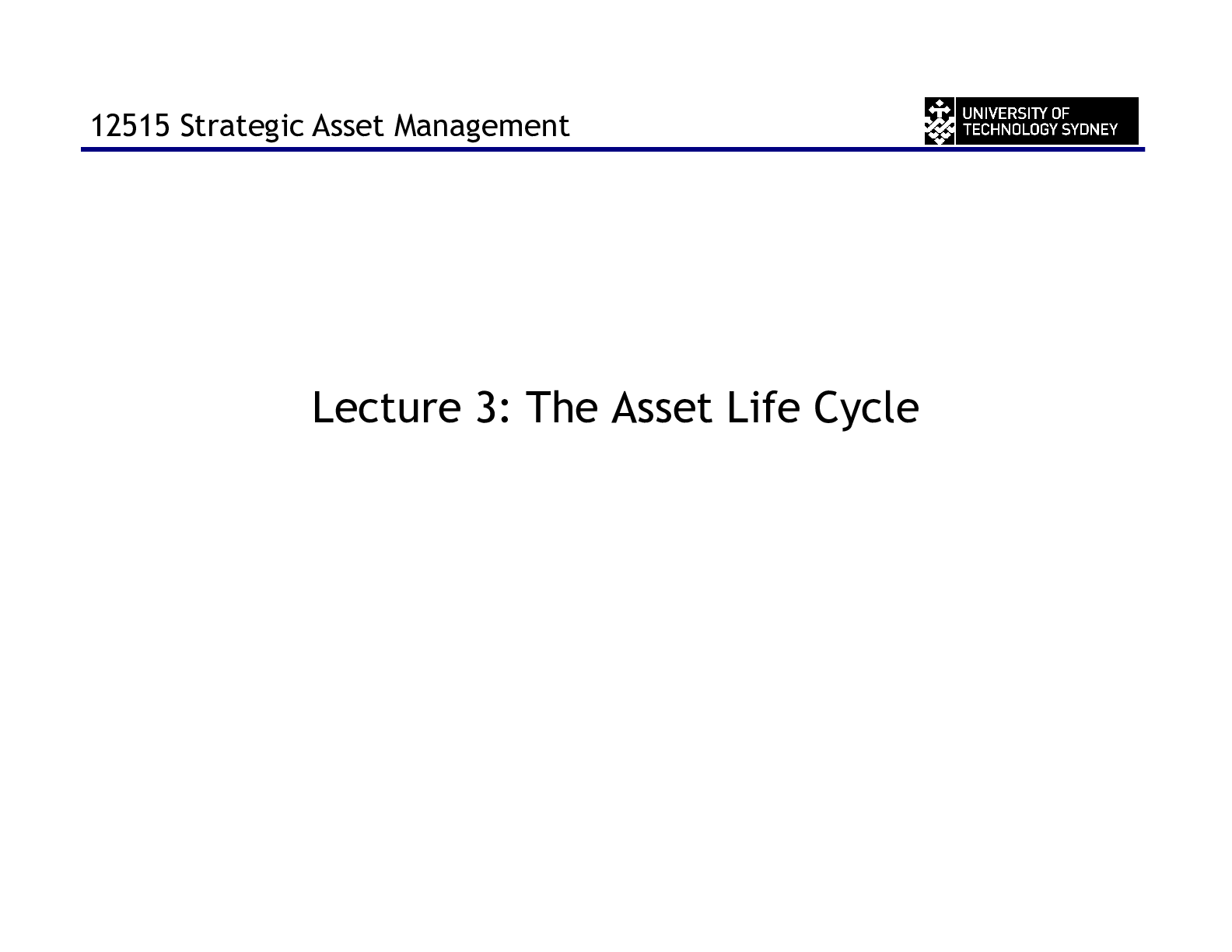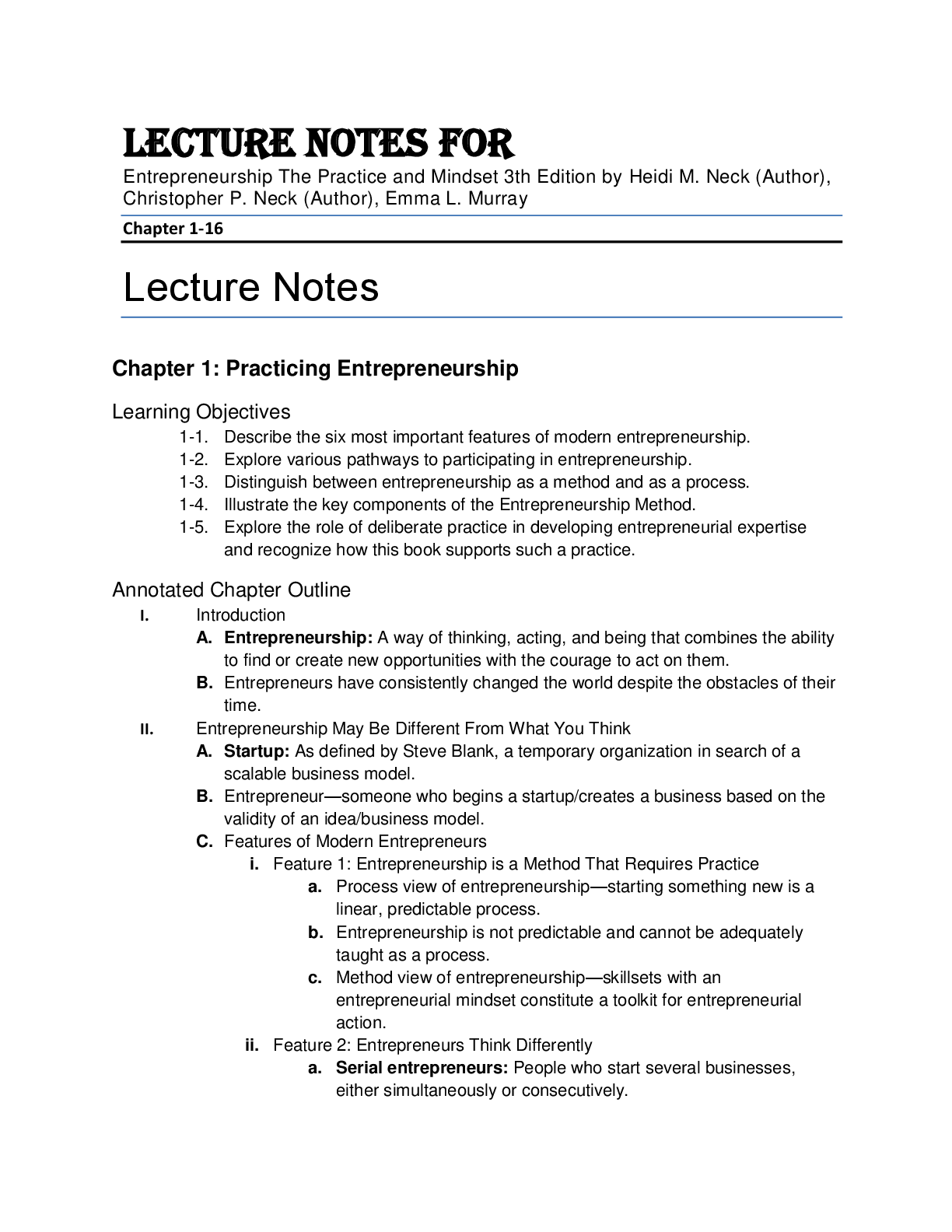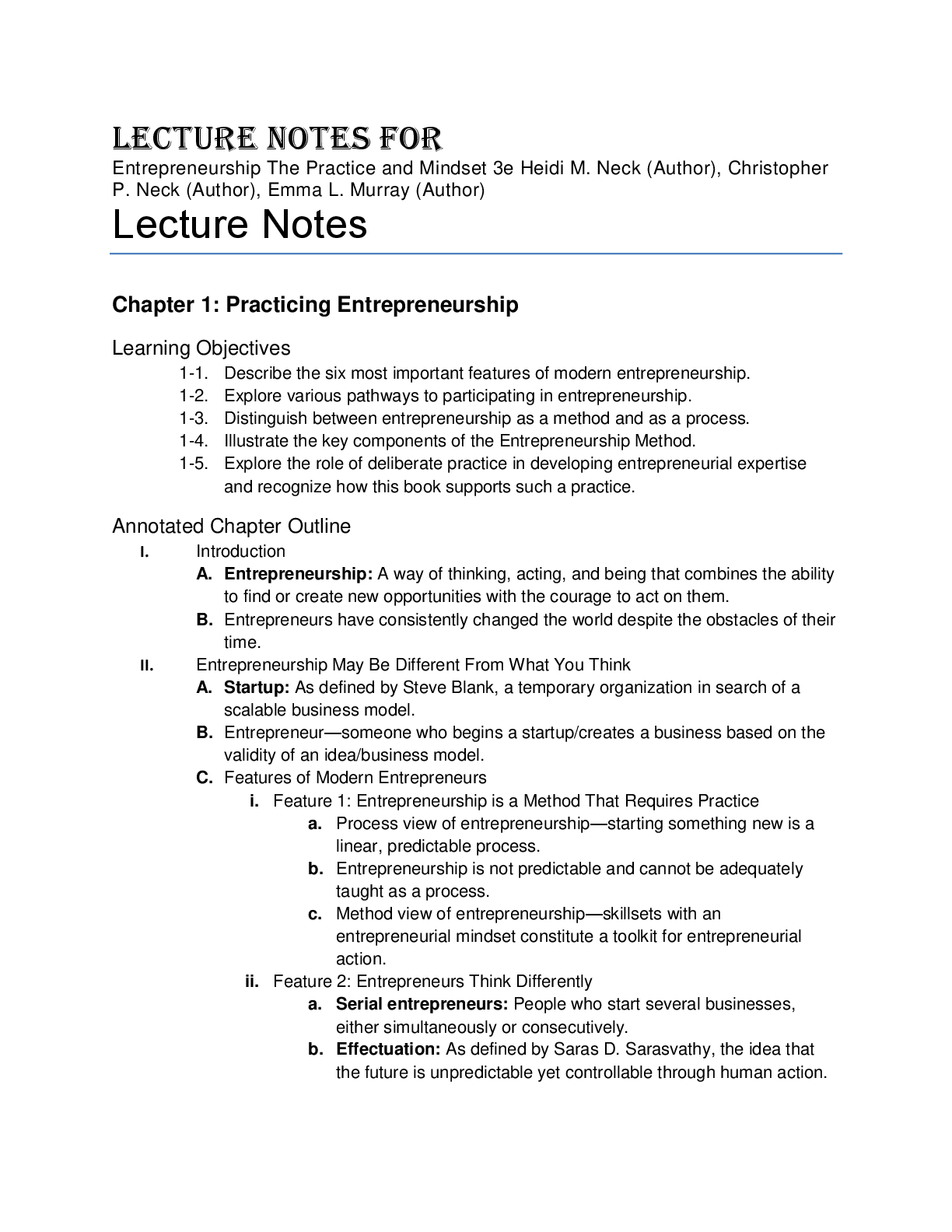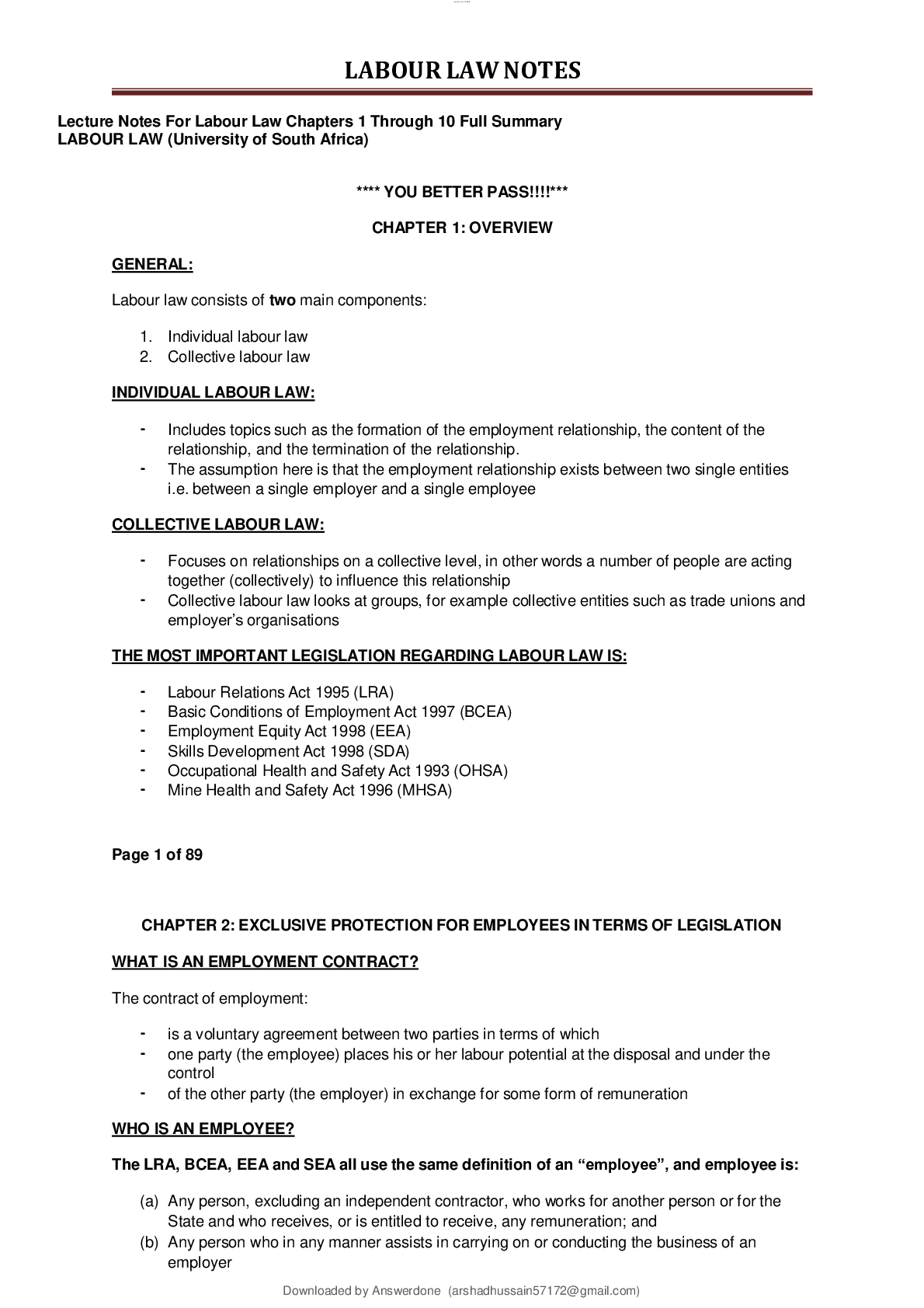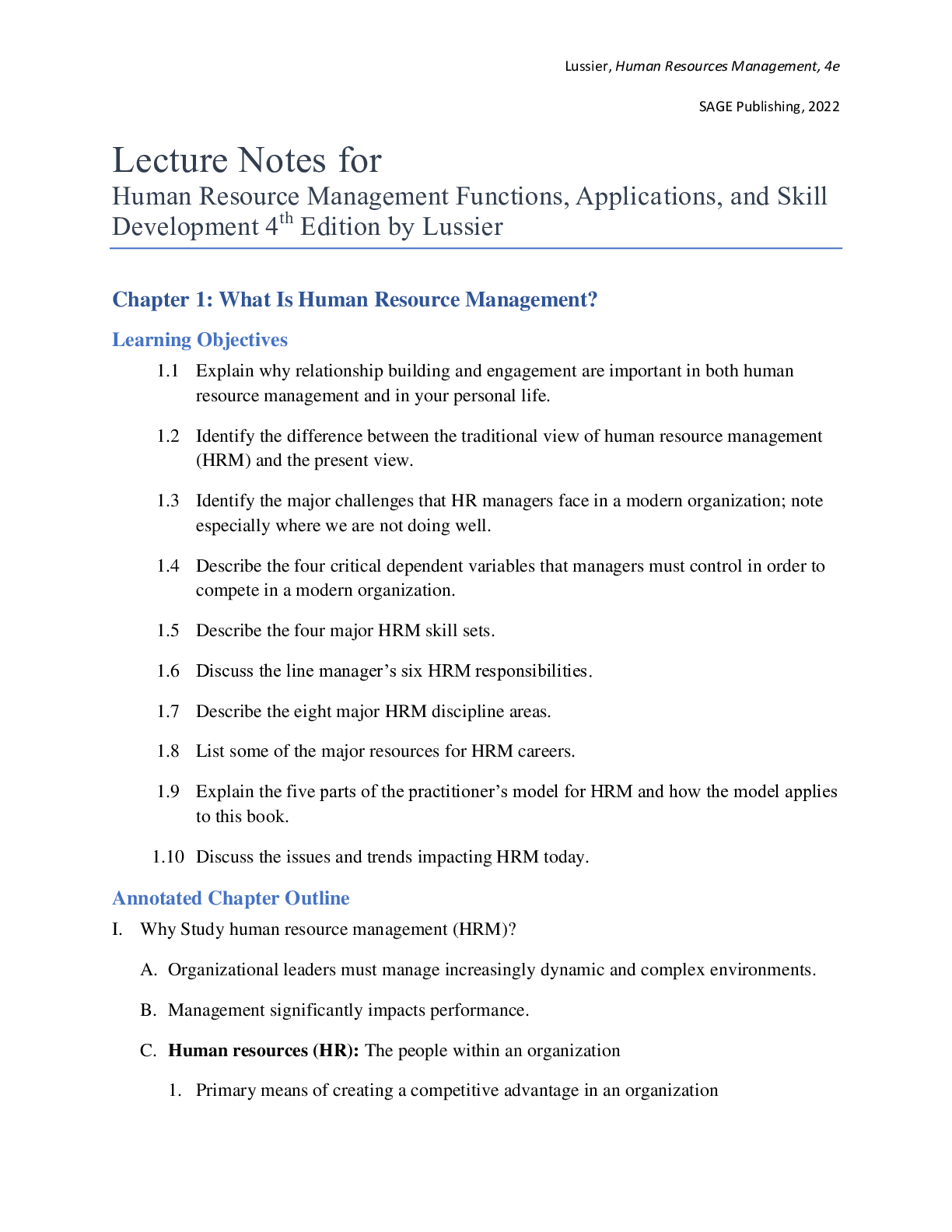Economics > LECTURE SLIDES/NOTES > ECON 1002: Lecture 1: Introductory Macroeconomics (All)
ECON 1002: Lecture 1: Introductory Macroeconomics
Document Content and Description Below
Lecture 1 Week 1: Learning outcomes By the end of week 1, you should be able to discuss The distinctions between microeconomics and macroeconomics The main macroeconomic performance measurements ... The concept of GDP Nominal versus real GDP Introduction to national accounting The limits of GDP as a measure of an economy’s performance What is economics about? Microeconomics Macroeconomics Macroeconomics is a set of theories about how the economy as a whole works It focuses on aggregate demand and aggregate supply It looks at national output, national employment, and the general level of prices Macroeconomics also examines a country’s economic relationship with the rest of the world Macroeconomics Macroeconomics Microeconomics provides a foundation for macroeconomics… And macroeconomics underpins many microeconomic decisions Macroeconomics’ main focus: the performance of a national economy Economic growth = rising living standard. When economic growth is high, the production of goods and services is rising, making possible increasing standard of living Macroeconomic theories are thus concerned with The factors that explain the increase in a country’s standard of living over time The role economic policy can play to speed up economic progress Main macroeconomics tools Measures of a country’s economic performance Macroeconomic theories to explain: The levels of certain economic variables (eg. economic growth, employment, prices, production…) The fluctuations of these variables Macroeconomic theories are also used to Forecast future levels of economic variables Understand and estimate the impact of economic policies and events Keep in mind… What is macroeconomics aiming to achieve? So why study macroeconomics today? Why study macroeconomics today? Macroeconomics is ubiquitous…and you know more macroeconomics than you think! Try and answer this: what are some of the implications for the low A$ exchange rates? For the economy? For you? Macroeconomics relevance to business (and your future employment) Some examples: Any firm: The current and future levels of interest rates are of utmost importance to businesses. Qantas: needs to be able to forecast future kerosene prices and passenger numbers. Economic growth forecast will help with forecasting both the demand for oil and the demand for travel. Rio Tinto: Needs to forecast commodity prices to decide future investment in its mining operation. Economic growth forecast in the major consumers of commodities will help to forecast the demand for commodities and ultimately commodity prices and the profitability of the mining industry. Understanding and managing major forthcoming issues Major issues with macroeconomics consequences which will shape our lives in the decades to come: Brexit, Europe, some future financial crisis Environmental challenges Global free trade … under threat? The rise of new world powers The impact of new technology Widening inequalities Population pressures … migration Macroeconomics also helps us answer questions such as: Why is Australia richer than India? Why some countries are so rich and others so poor? Why some countries are growing, or have stopped growing while others are not? Will the economy be better or worse by the time you graduate? Will the interest rate rise or fall next month? Will the Australian dollar be stronger or weaker next year? Why has wage growth been subdued for some time? Is the 2018-19 Budget good for the Australian econ? Major macroeconomic issues Economic growth and living standards: Some perspectives More than half the world’s population lives on less than US$4,000 per year. Average level of per capita income in Australia was US$55,507 in 2017. Korea had the same level of real income per capita as the Philippines in 1965; by 2010 Korea’s real income per capita was 6 times that of the Philippines In 1870, average real GDP per capita in the UK was 37% higher than that in the US. By 2010 average real GDP per capita is 32% higher in the US than in the UK Economic growth and living standards High standard of living in the US, Europe and Australia are the result of centuries of sustained economic growth, or the steady increase in the quantity and quality of goods and services produced (aggregate output). Because population growth accounts for a large share of the increase in output, a more accurate measure of standards of living is output per capita (we will look at that in more details later). Australia’s output Standard of living and Importance of Growth Rates A 1% growth rate over 40 years leads to an increase of 48% in the initial output per capita or standard of living 1.0140 - 1= 1.48 -1 = 48% “Rule of 70”: 1.0170 -1 = 1.007 = 100% Little (approximate) mental math tool: years to double=70/rate of growth So an economy growing at 2% per annum will double its output in 70/2 = 35 years. At 3% per annum, it will take 70/3=23 years. A broad look across time and space Growth of output per capita is a recent phenomenon and with it came major improvements in standard of living World population = 1 bn in 1900 7.7 bn today Life expectancy = 40 yrs “ 72 yrs “ Child mortality (<1yr old) = 25% “ 6% “ % read & write = 25% “ 80% “ Poverty (<US$2 per day) = almost 1 bn “ 1 bn “ Global standards of living are improving, mainly due to growth in China and India Growth (increasing standard of living) is not an economic certainty Growth (increasing standard of living) is not an economic certainty From the end of the Roman Empire to roughly 1500, there was essentially no growth of output per capita in Europe. From about 1500 to 1700, growth of output per capita turned positive but small. Even during the Industrial Revolution, growth rates were not high by current standards (in England growth was on average 1.3% between 1760 and 1820). Economic growth and living standards: major questions What caused this remarkable economic growth? Can it continue? Should it continue? Can it be replicated by other countries and how? Major macroeconomic issues 2. Labour productivity Average labour productivity (output per employed worker or per hour worked) is closely related to standard of living Average labour productivity has grown rapidly. However the rate of improvements in average labour productivity has slowed since 1997. Major questions: what causes the changes in the rate of improvements of average labour productivity? Productivity gains have slowed Major macroeconomic issues 3. Recessions and expansions Economies experience periods of particular weakness (recession) or strength (expansions or boom) Major macroeconomic issues 4. Unemployment The unemployment rate is the percentage of people who would like to work but can’t find work. It increases during recessions and generally decreases in boom time. Major questions: why does unemployment rise sharply in time of recession? Why is there always unemployed people even when the economy is booming? Why are unemployment rate so different between countries? Comparative unemployment rates Historical unemployment rates Major macroeconomic issues 5. Inflation Inflation is the rate at which prices are increasing over time. High rates of inflation imposes many costs on the economy. Major questions: why was inflation high in the 1970s and relatively low now? Why is inflation still so high in some countries such as Venezuela, Brazil and Zimbabwe? Is high inflation the price to pay for low unemployment? Global inflation rate Comparative inflation rates Week 1 – Week 4 Macroeconomics Building Blocks Measuring macro performance Output Prices and Inflation Savings, wealth and investment Unemployment Short-run macro: Economic fluctuations The Keynesian model of output determination in the short run Week 5- Week 12 Policy responses: Fiscal policy Monetary policy & the RBA Aggregate demand and supply Economic growth The role of saving Exchange rates & the balance of payments Measuring the performance of an economy: 1. OUTPUT Gross Domestic Product (GDP): a basic measure of living standard Australia’s recent economic performance Measuring GDP 3 ways to measure GDP Product approach Expenditure approach Income approach Product approach to measuring GDP The product method measures GDP as the sums of the value added at each stage of the production process (i.e wages+gross profit) Example of Product Approach Another example of Product Approach Farmer Chin produces 100L of milk. She sells 40 litres at 1$ per litre and feed the rest to her pigs which she sells for 120$. Her contribution to GDP is: 40+120=160 Now assume that she pays a farmhand 10$ to produce those 100L of milk. Her contribution of GDP is: 10 (wages) + gross profits (40+120-10) = 160 Now assume farmer Chin purchases 100L of milk at 0.50cents per liter. She sells 40 litres at 1$ per liter, feed the remaining to the pigs which she sells for $120. Her contribution to GDP is: 160-50=110 GDP: Expenditure measure Calculates GDP by adding up the aggregate expenditure on all final goods and services produced during the year in a country. It includes Personal consumption expenditures (purchases of services, non-durable goods and durable goods expected to last at least 3 years). Investment: New physical capital, new residential construction and changes in inventories . Government consumption and investment Net exports of goods and services GDP: Expenditure measure Australia’s recent economic performance GDP: Income measure The income approach to GDP sums the incomes to all those involved in the production process GDP(I) = W + Π +MI+ (IT - Sb) where: W = wages, salaries, employers’ social contributions and supplements (rents, dividends, interest…) Π = gross operating surplus (profits) MI= gross mixed income (income from unincorporated businesses) IT = indirect taxes Sb = subsidies W + Π = domestic factor income W + Π + MI = GDP at factor cost (ie cost of factors of production) Direct taxes, indirect taxes, subsidies and the Income Account A comparison Example Let’s go back to the example of the production of bread. And let’s suppose an economy where only bread is produced, sold and consumed. Product approach to GDP (sum of value added at each stage of the production process): GDP=120+120+140=380 Income approach to GDP (sum of wages,profits) GDP=80+40+50+70+40+100=380 Expenditure approach to GDP GDP=380 (ie price of bread at the end) The circular flow of income in a two-sector model Limitations of national accounting methods GDP underestimates the size of the economy Household production and non-market economic activities are not included in GDP Because non-market economic activities are not counted in official statistics, GDP data substantially underestimate the size of the economy and par extension the standards of living of the country. It is particularly true in developing countries which may substantially underestimate the true amount of economic activity in the poorest country. The underground economy Only about 3% of GDP in Australia Underground economy in Greece is about one quarter of GDP, according to University of Macedonia Professor Vassilis Vlachos. Underground economy estimated at up to 40% in Brazil Value of household production relative to GDP Limitations of national accounting methods There are 3 key GDP concepts Nominal versus real GDP Nominal GDP: Value of output at the prices prevailing in the period during which the output is produced. It is useful for comparisons across countries. Real GDP: Output produced in any one period at the prices of some base year. The growth rate of the economy is the rate at which real GDP is increasing. It produces a more accurate view of changes in a country’s total production over time as it strips the impact of rising/decreasing prices. Example: concept check 2.5 Levels of GDP versus growth of GDP Economic growth rate: percentage increase in output over a 12-month period (Real GDP2018/Real GDP2017)*100-100 GDP versus GDP per capita GDP per capita is a most important indicator of an economy’s relative long-run performance. With more people a country can produce more, therefore larger countries will have higher GDP than smaller countries Given rising population, current GDP data overstates the increase in GDP overtime As a result, to look at a more accurate picture of the growth in GDP overtime and across countries, we need to look at GDP per capita or GDP divided by the total population of a country Real GDP per capita is the most accurate indicator of standard of living across space and time. What is so important about the standard of living? Real GDP is not the same as economic well-being Growth, standard of living and happiness Growth, standard of living and happiness The Easterlin Paradox: Rich people are happier than poorer people on average, and richer countries are happier than poorer countries. yet growing national income is not always accompanied by growing national happiness. This suggests: Once basic needs are satisfied, higher income does not increase happiness What matters is relative income Income distribution matters more than level of income. Still, a recent study points to a strong relation across countries between average income and average happiness Food for thoughts… Rich nations should change their goal from one of economic growth to that of "increased happiness in a situation of stable income and declining population". In our developed economies, "people buy things they don't need, with money they don't have, to impress people they don't like". Charles Sturt University Professor of Public Ethics Clive Hamilton The Australian Bureau of Statistics (ABS) has been leading the world in developing new measures of progress and wellbeing. ABS Deputy Australian Statistician Peter Harper is overseeing Measures of Australia's Progress (MAP), which moves away from using GDP as a key measure of a nation's progress and instead considers progress to be "multi-dimensional covering a range of economic, social, environmental and, more recently, governance concerns". Australia’s recent economic performance [Show More]
Last updated: 3 years ago
Preview 1 out of 77 pages

Buy this document to get the full access instantly
Instant Download Access after purchase
Buy NowInstant download
We Accept:

Reviews( 0 )
$2.00
Can't find what you want? Try our AI powered Search
Document information
Connected school, study & course
About the document
Uploaded On
Nov 28, 2019
Number of pages
77
Written in
All
Additional information
This document has been written for:
Uploaded
Nov 28, 2019
Downloads
0
Views
203


